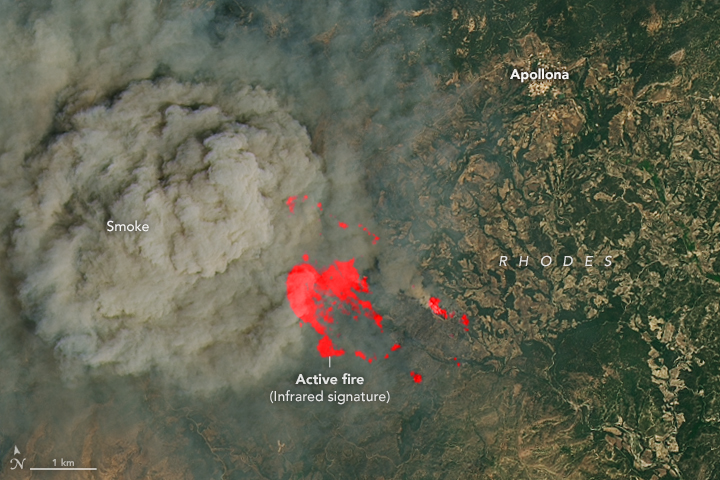
Fires Ignite on Greek Islands
Downloads
- rhodesislandfire_oli_2023200_lrg.jpg (1292x1685, JPEG)
Metadata
- Sensor(s):
- Landsat 8 - OLI
- Data Date: July 19, 2023
- Visualization Date: July 25, 2023
Wildfires raging across the Greek island of Rhodes sent tens of thousands of locals and tourists scrambling for safety in late July 2023. A prolonged stretch of extreme heat contributed to high fire risk across much of the country. Blazes also ignited on the mainland and the islands of Corfu and Evia.
The Operational Land Imager (OLI) on Landsat 8 acquired this image of fire activity on Rhodes on July 19. The image is natural color, with the infrared signature from actively burning fires overlaid in red. Thick smoke can be seen drifting westward toward the Aegean Sea.
This image captures the start of what turned into an intense period of wildfire. NASA-affiliated scientists were able to track the fires’ spread with the Visible Infrared Imaging Radiometer Suite (VIIRS) sensor on the NASA-NOAA Suomi NPP satellite. Calculating the perimeter of actively burning areas every 12 hours, Eli Orland and Tess McCabe observed how the Rhodes fire spread relatively slowly at first, then picked up rapidly. Between July 21 and July 23, it underwent a six-fold increase in size, from approximately 25 to 150 square kilometers (10 to 60 square miles), according to their analysis. Orland is a research associate at Goddard Space Flight Center and the University of Maryland, Baltimore County, and McCabe is a post-doctoral associate at the University of Maryland, College Park.
An estimated 19,000 people evacuated from areas threatened by the blazes, according to news reports. Many sought refuge in makeshift shelters such as schools, gymnasiums, and docked ships, while some in seaside villages boarded coast guard vessels to move to safety.
As of July 24, there were 82 fires burning across Greece, with 64 of those starting on July 23. In addition to the many people impacted on Rhodes, upwards of 2,500 people on Corfu were evacuated, and residents of villages in southern Evia found themselves in harm’s way as high winds fanned the flames.
Fires are not unusual in Greece, but heat-stoked fire weather is projected to become more common as the planet warms. The intense fire season of 2021 came on the heels of extreme heat, and the number of fires and area burned in Greece were far above average. Experts think the current heat wave is set to become Greece’s longest on record, with temperatures exceeding 40°C (104°F) for days on end in late July. The area burned by fires is more than double the average for this point in the year.
NASA’s Earth Applied Sciences Disasters program area has been activated in support of the fires in Greece, responding to a request from the World Central Kitchen for data and imagery of the fires’ location and impacts to inform their humanitarian efforts in setting up kitchens for those affected. As new information becomes available, the team will be posting maps and data products on its open-access mapping portal.
References & Resources
- The Guardian (2023, July 23) How bad are the wildfires in Greece — and what caused them? A visual guide. Accessed July 25, 2023.
- The Independent (2023, July 25) Where are the fires in Corfu and Rhodes? Map reveals Greece wildfires. Accessed July 25, 2023.
- NASA Earth Observatory (2021, August 12) Fire Consumes Large Swaths of Greece. Accessed July 25, 2023.
- The New York Times (2023, July 23) Raging Fires on Greek Island Force Thousands to Scramble for Refuge. Accessed July 25, 2023.
- Reuters (2023, July 21) Wildfires in Greece burn for fifth day as another heatwave hits. Accessed July 25, 2023.
NASA Earth Observatory image by Lauren Dauphin, using Landsat data from the U.S. Geological Survey. Story by Lindsey Doermann.
This image record originally appeared on the Earth Observatory. Click here to view the full, original record.